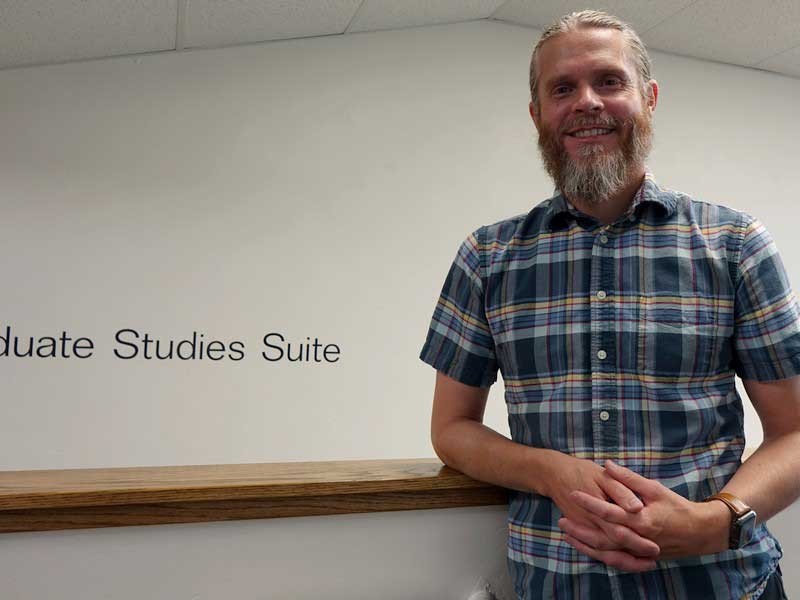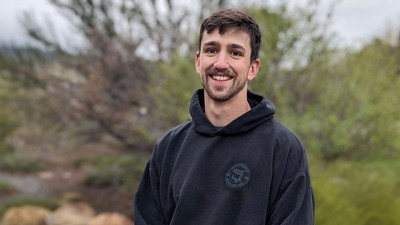Canvas Awards Prof for Teaching Skills to Make Class Material Accessible
By Janelle Hyatt |
Jared Colton, associate professor of Technical Communication and Rhetoric in the Department of English, was named by the maker of the learning platform Canvas as the 2019 Higher Education Associate Professor of the Year. He is also the English Department's graduate studies director.
Nearly 100,000. That’s the astounding number of PDFs in Canvas not easily accessible to students who are blind or otherwise disabled. And that’s just the number detected during a single semester last spring.
Because Canvas is a learning-management platform that undergirds all Utah State University academics, it’s used by nearly every student and professor.
Students look up syllabi, group-chat with classmates, download assignments, take quizzes, turn in homework, email professors. At semester’s end, Canvas posts the grade.
It’s easy to see why this inability to use Canvas to its full potential is, in one word, a handicap.
Now, Instructure, the global company that created Canvas, has named a USU Technical Communications professor as an Educator of the Year.
Jared Colton, an associate professor of Technical Communication and Rhetoric in the Department of English, stood before a full auditorium at a recent Canvas conference to accept an award as the 2019 Higher Education Associate Professor of the Year for his work in what the company described as redefining traditional classroom lessons to better prepare students for a changing world.
Colton’s accomplished that by teaching his students to address, and mitigate, a problem they couldn’t necessarily see — that much of our dynamic culture of technology remains inaccessible to people with vision impairment, cognitive difficulties or deafness.
To increase accessibility, the students adopted the computer language HTML, which is used to structure web pages and, when done right, adds multiple ways to better navigate the internet. As Christopher Phillips, an accessibility expert on campus who worked with Colton, explained: “Students were able to learn not only the moral obligation of accessibility and community involvement, but also some really important editing skills.”
So, about those nearly 100,000 PDFs. Phillips, of USU’s Center for Innovative Design and Instruction, says PDFs are especially problematic because, whether turned sideways, blurry, or unreadable because the book binding doesn’t lie flat, they can be an accessibility nightmare.
But, because they’re easy to create and easy to open, PDFs were long considered best practice, he said. Smart phones and 3-inch screens changed that.
To make a PDF accessible, an optical character reader transcribes the PDF text onto a Canvas page. At that point, said Colton, students proofread, make corrections and then use HTML to add markers that make the page easier to follow and skim. It doesn’t hurt that the PDF upgrade makes life much easier for sighted students as well.
Phillips tracks down the tens of thousands of bad PDF actors using a tool that scans Canvas campus wide. He then narrows that selection based on how widely the PDF is used in classes.
Colton’s students first began practicing their accessibility skills by adding captions to the videos used by USU for recruiting and other promotion. They then moved on to browser coding and other technology. Over the semester Colton’s students and other helpers revamped some 1,000 Canvas-based PDFs, said Phillips.
That’s what caught the attention of Instructure.
“I was teaching my students these tools to caption video and code documents to make them more accessible,” Colton said, “but also talking about the ethics of being more inclusive and thinking of broader audiences, not just people like themselves.”
Learning a computer language like HTML, which sounds scary to non-tech students, didn’t faze those majoring in Technical Communication, said Colton. Students in this major research the issues of our work-a-day writing we use regularly but don’t see as actual writing. Think instruction manuals, forms, loan application, even the U.S. Census.
There are those, however, “who do get anxious,” he said. “They approach me and say, ‘I thought this was just a writing class.’
“I say, ‘You are writing. This is a form of writing.’ We may not consider a video or web design as writing, but they all incorporate writing on some level.”
What distinguishes USU’s Technical Communication program from others throughout the United States is its focus on social justice and the desire to “have our work create an impact beyond one student,” said Colton.
WRITER
Janelle Hyatt
Communications Director
College of Humanities and Social Sciences
(435) 797-0289
janelle.hyatt@usu.edu
CONTACT
Janelle Hyatt
Communications Director
College of Humanities and Social Sciences
(435) 797-0289
janelle.hyatt@usu.edu
ADDITIONAL RESOURCES
TOPICS
Awards 691stories Faculty 303stories Online Education 44storiesComments and questions regarding this article may be directed to the contact person listed on this page.






